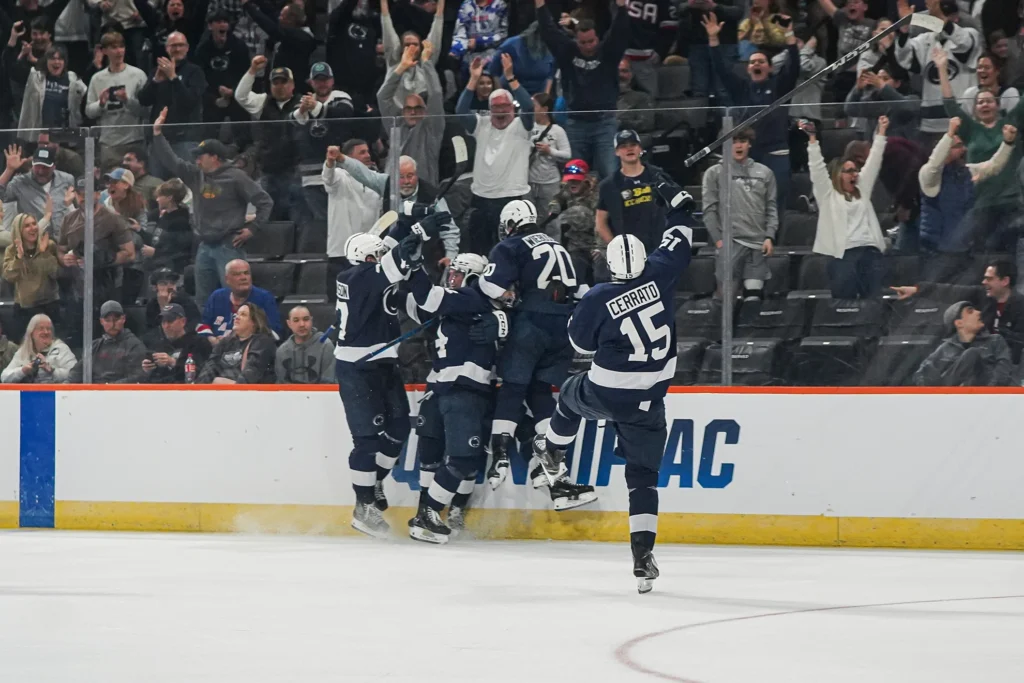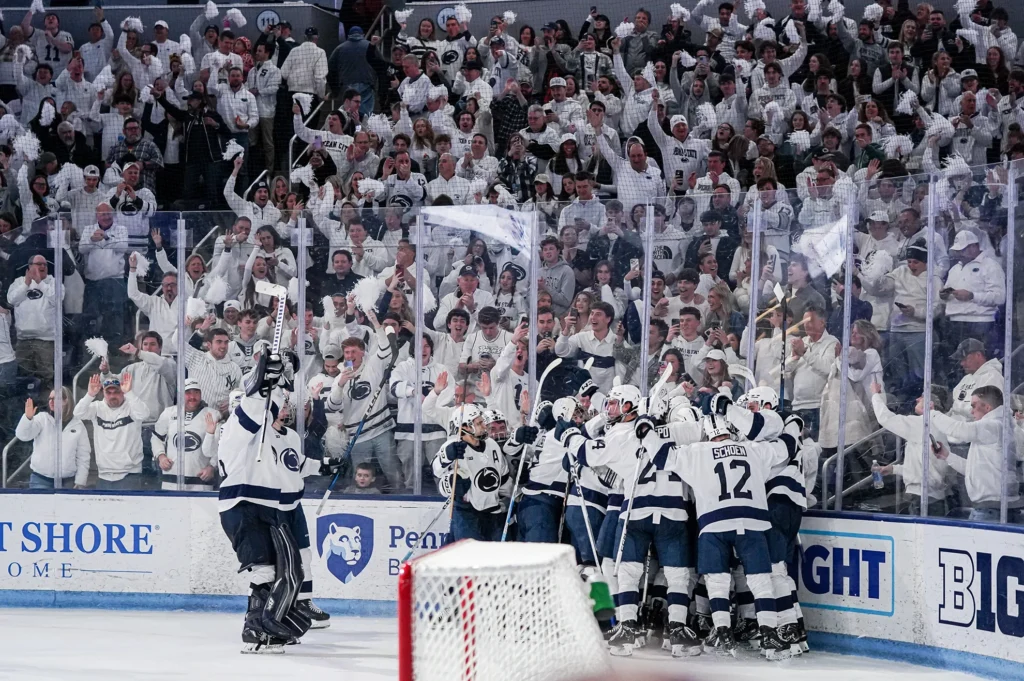
In the days leading up to Penn State’s Frozen Four game, the media spotlight shined brightly on Guy Gadowsky’s team.
Rightfully so.
It was the first time in the program’s history that the team, not the arena it played in, was nationally relevant. Not just inside of the Penn State hockey circle and fandom, but of college hockey fans, of college sports, of Penn State fans who only occasionally remember that there is a Division I program now.
It was a program getting media and fan attention for what it was doing on the ice. For those plugged in or for those who keenly follow Penn State’s hockey team, it was exciting – adding to the looming anticipation of a Frozen Four berth.
Of the many articles written under that spotlight, usually by those that cover Penn State’s football team, there were retellings of Penn State’s origin story. At the center of most of those articles, much like at the center of the origin story of Penn State’s Division I program, was Joe Battista. The former Icers coach recounted the early days of the program, the dinner with Terry Pegula and the text that confirmed it all.
But he also reflected on something else: Matt DiMarsico’s overtime goal – and what the moment meant.
“The current players may not understand that yet,” Battista said in an interview with long-time Penn State beat writer Mark Wogenrich. “They went out and won a hockey game, and that’s special for them. That bond will last forever for them. But the influence, the impact that it had on a much greater scale, is something they won’t understand for years.”
Nothing will sum up what this Penn State men’s hockey season, what the run from January to St. Louis, and what the Frozen Four berth meant quite like that quote can.
Even with a 3-1 loss to Boston University in the Frozen Four, this Penn State men’s hockey season changed so much for a program that up to this point was only known to many on the outside as the team with a loud rink.
Now, it’s time to take Penn State’s hockey program seriously. Now, Penn State men’s hockey can be taken seriously.
That isn’t to say that hockey at Penn State has never been taken seriously. Of course, Battista’s teams took their repeated ACHA crowns seriously. Of course, Pegula’s gift meant that Penn State could take hockey seriously. Of course, Gadowsky’s teams have taken hockey seriously over the years.
But in the general grand scheme of Nittany Nation, there had been this collective idea that hockey was still a bit of a novelty.
Very rarely was the conversation about Penn State’s men’s team about the team – but rather the atmosphere at the games around those teams. A ticket to Pegula was and is (and will be) one of the hottest in town for the last 13 years.
But what DiMarisco did this season, what Aiden Fink did, what Arsenii Sergeev did and what the rest of Penn State 2024-25 team did is something that hasn’t been done yet.
They made this season about the output, about the potential, about the possible.
Back in early December, in the midst of Penn State’s losing streak largely due to Sergeev battling injury, there was a collective sense of worry about Gadowsky’s fate as head coach moving forward.
Yet that conversation was rightfully overshadowed by Penn State’s football College Football Playoff run.
Aside from a Big Ten tournament title in 2017, there hadn’t been much to show.
That all began to change, however, when the calendar flipped to January, in ways that have been well-documented, because of the way the coach got his team to play.

Spurred by Fink’s strong scoring ability that made him a legitimate Hobey Baker candidate and Sergeev’s impressive netminding, Penn State crawled its way from the Big Ten basement to relevancy that hasn’t been seen by this program yet.
People were having conversations based on Penn State’s play – not just about how loud Pegula Ice Arena can get. People were learning the names of “Fink” and “Cerrato and “Wiebusch” the way they learn “Allar” and “Singleton” and “Warren.”
And with Penn State’s hoops programs flailing about per usual, Penn State’s men’s hockey team filled the post-football season itch for a sports-crazed fan base with impressive performance after impressive performance. There was legitimate buzz happening – even from the time Penn State squeaked its way into the NCAA Tournament – that had never happened before. Much of it centered around how all of this wasn’t a fluke.
When they made that tournament, backed by a largely pro-Penn State crowd in Allentown, a dominant win over Maine showed that Penn State wasn’t going to let its season end quietly either, and by Sunday, the tiny snowball that started back in January had become a full-on avalanche, crashing down when DiMarisco beat UConn’s Callum Tung on a wrist shot 17 minutes and 54 seconds into overtime.
Not only had Penn State smashed through the ceiling it had been stuck at – the regional championship it had lost twice before – it had brought new levels of attention to this program that haven’t been seen since the 2013 opening of Pegula Ice Arena.
Yet this time around that buzz wasn’t centered on the building but the team.
Out of it, Penn State hooked new fans. Penn State reinvigorated old fans. Most of all, Gadowsky’s team proved to so many that hockey is not and will not just be a novelty moving forward.
Of course, this almost happened in 2020. Many people think that team, which was 20-10-4 and a potential top-four seed in the NCAA Tournament, was going to be the one that truly put Penn State on the map. With players like Nate Sucese, Alex Limoges and Peyton Jones, it was a team destined to rip this program away from that novelty-like feeling.
Then COVID hit and ripped all of that momentum away.
Among teams impacted most heavily by the global pandemic in Happy Valley, Penn State’s men’s lacrosse and men’s hockey teams lost the most ground.
But that ground has been made up in recent days.
For once — and for some, finally — people are looking at Penn State men’s hockey with actual, tangible aspirations the way other sports are around campus. There is a sense that hockey at Penn State can be seen with serious intent as opposed to the shiny new toy.
And that’s what this season changed.
The lasting impact of DiMarsico’s goal isn’t just that Penn State got to the Frozen Four. It’s that now Penn State also understands what it takes to win and what happens when it wins.
All of those doors, as Battista alluded to, were unlocked with that goal.
That, too, brought on a lesson of just how tough it is to win when the present level of talent doesn’t match up with a team like BU and its 14 NHL draft picks in a single elimination affair.
But there’s a real sense that things are growing. Penn State’s young core – guys like Fink, DiMarsico, JJ Wiebusch, Charlie Cerrato and Dane Dowiak – got a taste of winning and what can be possible. Next year, they’ll be one more year older and with maybe the best recruiting class ever coming to Hockey Valley, there’s a sense of optimism that the success can be sustained.
Now though, there will be anticipation for next season. Now there will be recognition for what’s possible. The Frozen Four is, after all, the most-watched college hockey event in the country.
And there was Penn State.
In living rooms. In bars. In St. Louis. In the spotlight.
Making serious waves like never before.
If you’ve enjoyed this content, please subscribe to Stuff Somers Says With Steve on YouTube. Or join our newsletter by entering your email below.
